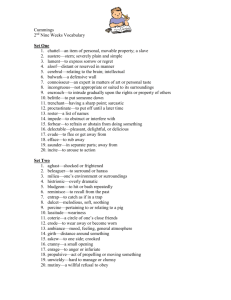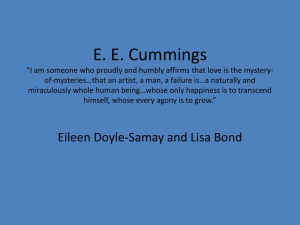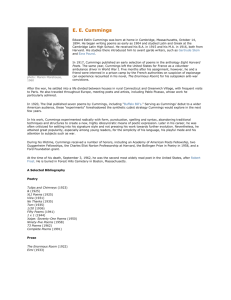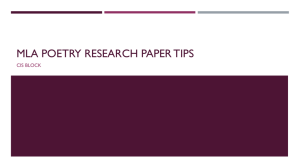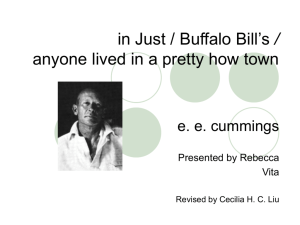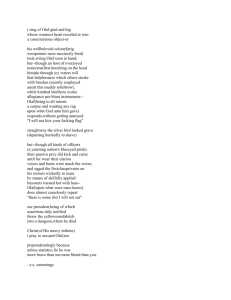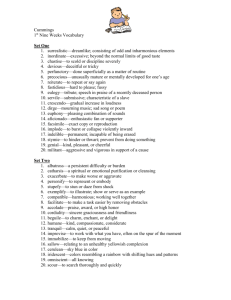News, Notes, & Correspondence
advertisement
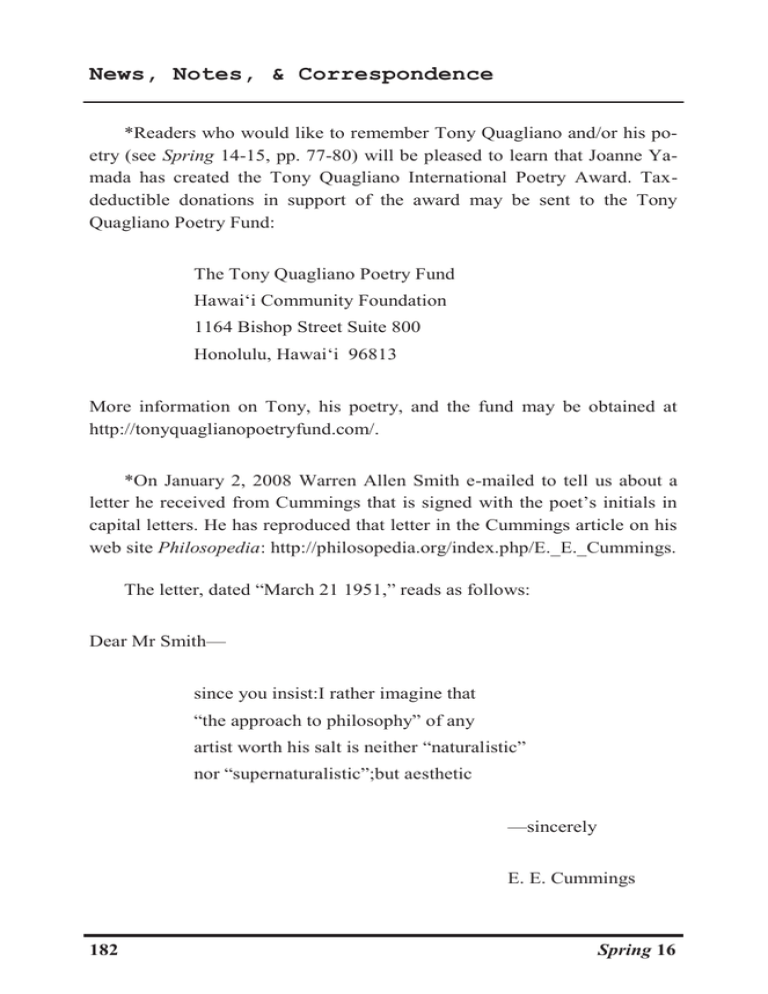
News, Notes, & Correspondence *Readers who would like to remember Tony Quagliano and/or his poetry (see Spring 14-15, pp. 77-80) will be pleased to learn that Joanne Yamada has created the Tony Quagliano International Poetry Award. Taxdeductible donations in support of the award may be sent to the Tony Quagliano Poetry Fund: The Tony Quagliano Poetry Fund Hawai„i Community Foundation 1164 Bishop Street Suite 800 Honolulu, Hawai„i 96813 More information on Tony, his poetry, and the fund may be obtained at http://tonyquaglianopoetryfund.com/. *On January 2, 2008 Warren Allen Smith e-mailed to tell us about a letter he received from Cummings that is signed with the poet‟s initials in capital letters. He has reproduced that letter in the Cummings article on his web site Philosopedia: http://philosopedia.org/index.php/E._E._Cummings. The letter, dated “March 21 1951,” reads as follows: Dear Mr Smith— since you insist:I rather imagine that “the approach to philosophy” of any artist worth his salt is neither “naturalistic” nor “supernaturalistic”;but aesthetic —sincerely E. E. Cummings 182 Spring 16 *In Spring 11 we published a painting by Ruth Shackford of Cummings‟ New Hampshire house, Joy Farm. On September 9, 2008, Ruth sent us a greeting card adorned with a new painting of Joy Farm. She wrote to us from Silver Lake, NH: My husband and I were caretakers for The Cummings‟ from the early fifties until Marion‟s death. They were very dear to us and we have fond memories of the years we worked for them. I recently painted the oil painting on the note paper of the Cummings farm, Joy Farm, just as it was when we took care of it for them. It has now been altered and [is] not such a beautiful set of buildings. This past year I have been asked to speak at several Historical Societies and other meetings to talk about my memories of them. If you would like to include this painting in the next edition you certainly have my permission. A picture of an oil painting I did of Estlin‟s beloved Mt. Chocorua was included in the Spring 1999 issue. [See Spring 8, pages 17-18 and the note below on Yasuo Fujitomi‟s broadside, Chocorua.] I also enjoy the Journal and appreciate how much work goes into it. Thank you for all your effort. Cordially, Ruth Shackford Fall 2007 183 In addition to the reproductions of paintings that appeared in Springs 8 and 11, Ruth Shackford also made an appearance in Spring 6 as a recipient of correspondence from Marion and E. E. Cummings. See Norman Friedman‟s article, “Letters from the Cummingses to Ruth Shackford” [Spring 6 (1997): 18-21]. For two photos of the 2007 “E. E. Cummings Exhibit” at the Madison, New Hampshire, Library, see: http://www.flickr.com/photos/ madison library/799694541/. *On June 15, 2007 Sarah Wasserman wrote to say that she was getting married on the following day, known as Bloomsday in the James Joyce calendar: So tomorrow's the big day. We're having a small civil ceremony in the afternoon, and then a reception with friends and family in the evening. Before dinner, Tony and I are going to read a passage from Ulysses. It‟s one of our favorite books, and when June 16 fell on a Saturday this year, it was too great to pass up. I'm also incorporating Cummings into my vows, reading “i carry your heart” at the wedding. That's one of my favorite poems (but I have so many favorites...). *Larry Chott wrote to tell us that New York Observer reported on June 13, 2007 that the memorial service for journalist David Halberstam featured “music from Paul Simon (who managed to make “Mrs. Robinson” sound mournful), as well as a song from the author‟s neighbor, Peter Yarrow. . . There was fine oratory from Congressman John Lewis; an e.e. cummings [sic] poem from Halberstam‟s daughter, Julia, and thunder—actual thunder—when a fireman Halberstam had written about recalled 9/11, and again when Congressman Lewis described the early struggles of the Civil Rights Movement. Those celestial sound effects would have made Halberstam smile.” No word yet on which Cummings poem was read. Books and Publications by Society Members and Friends *Several EEC Society members have been published in the collection of essays edited by Jiri Flajsar and Zénó Vernyik, Words into Pictures: E. E. Cummings’ Art Across Borders (Cambridge Scholars Publishing, 2007). The Table of Contents is as follows: 184 Spring 16 List of Illustrations………….………………………………………... vii Acknowledgements………………………….………………………. viii Introduction……………………………………………..……………... x Chronology………………………………………………………… xviii Part I: New Contexts Cummings and the Brotherhood of Visual Poetics……………………..2 Richard Bradford Reflecting EIMI: The Iconic Meta-Sonnet, Manhood, and Cultural Crisis in E. E. Cummings‟ No Thanks………………………. 27 Gillian Huang-Tiller The Posterity of Idiosyncrasies: E. E. Cummings‟ Influence on Post-War American Poetry………………………..………..............58 Isabelle Alfandary Part II: Political Cummings From Bad Boy to Curmudgeon: Cummings‟ Political Evolution….….68 Milton Cohen Divine Excess: The Logic of General Economics in The Enormous Room…………………………………………….….90 Ehren Helmut Pflugfelder Part III: Cummings in Space “as usual I did not find him in cafes”: I-space, “i” space, and Spatial Cognition in E. E. Cummings‟ Poetry………….….……..108 Taimi Olsen Sacred-Evil New York: Urban Spatiality in Tulips & Chimneys……………………………….126 Zénó Vernyik Part IV: Amongst Arts Crossing Generic Boundaries: Sculpture, Painting and Engraving as Compensations for E. E. Cummings‟ Hermeneutic Short-Cuts.…...156 Claudia Desblaches “With chasteness of sea-girls”: Björk‟s Adaptation of E. E. Cummings‟ Poetry……………………………………..……..170 Emília Barna Part V: Identity and Subjectivity Beyond the Scope of the “I” in E. E. Cummings‟ Leaf Poem…….......188 Kurt Harris Fall 2007 185 Notes………………………………………………………….….….. 201 List of Contributors…………………………………………….…..... 210 Index……………………………………………………..…………...214 *In the fall of 2008 Yasuo Fujitomi sent us a complete edition of his chapbook series, Chocorua, named after the mountain visible from Joy Farm that Cummings painted many times. Except for the tenth and last issue, each Chocorua is an envelope-sized folded broadside, with six leaves, or pages. Issue ten has eight leaves. Each issue features Mr. Fujitomi‟s translations into Japanese of one or more Cummings poems or short texts, along with commentary. We reproduce here a photo of issue ten. Cummings‟ poem “in Just-” (CP 27) is printed on the back of the tshirt . *Consulting Editor and Spring contributor Iain Landles has just published The Case for Cummings: A Reaction to the Critical Misreading of E.E. Cummings with VDM Verlag, Cologne, Germany. We have yet to see a copy of the book—anyone out there want to review it? The News from Poets *The poems of Jacques Demarcq in this issue are from his recent collection, Les Zozios (which might be translated as The Birdies), published by Nous. In addition, Demarcq has bravely begun to translate EIMI into French. The first two chapters of this monumental effort have been published in the very handsomely produced issue # 12 of the literary-artisticcinematic-gastronomic-sporting journal known as Fusées. *John Edwin Cowen has edited the Collected Poems of José García Villa, titled Doveglion, whose cover features the famous Marion Morehouse photo of Villa that first appeared in Marion‟s photo book Adventures in Value (1962). [For Thomas Dorsett‟s review of Doveglion and a photo of 186 Spring 16 the cover, see pages 163-175 in this issue.] Doveglion (Villa‟s pen name— for dove, eagle, and lion) contains Villa‟s collected poetry, including rare and previously unpublished material. Cowen‟s poems in this issue are from his “first volume of selected poems,” Mathematics of Love (Bravo Editions, 2008). Cowen also sent us a vintage text by Arthur Vanderborg called, appropriately enough, introducing mr. vanderborg: poems. (King & Cowen, 1977). This book is the best place to start in finding an answer the question posed by Cowen‟s poem in this issue, “Who Is Arthur Vanderborg?” [See page 77.] Gerald Locklin Retires from Teaching, Keeps Writing *In the spring of 2008, Gerald Locklin retired from teaching after 43 years at California State University, Long Beach. In an article in Inside CSULB announcing his retirement, Locklin said that there “aren‟t many people who get to make their living doing something they enjoy as much as I enjoy teaching. It is has been a great privilege to have taught here all these years, with students I have thought of as friends, and colleagues for whom I have the greatest respect. Teaching has truly been its own reward—though I haven‟t sent back any paychecks either” (Manly). A long-time contributor to Spring, Locklin “is the author of more than 110 books of poetry and fiction and thousands of works in periodicals, and has seen his work preserved by the CSULB University Library in its Special Collections” (Manly). For the KPCC Southern California Public Radio story on Locklin‟s retirement “poetry festschrift” party, see http:// www.scpr.org/news/stories/2008/05/27/08_locklin_retires_0527.html . Though he has retired from teaching, Gerry has certainly not retired from poetry. The poems featured in this issue of Spring may all be found in The Cézanne / Pissarro Poems (World Parade, 2007). He has also recently published New and Selected Poems (World Parade, 2008) as well as the ristorante godot (Bottle of Smoke Press, 2007, with illustrations by Henry Denander). In addition, Locklin is one of two poets featured in Chapbook # 60 from Zerx Press, Thank You, Dave: A Brubeck Tribute (2007). The flip side of the chapbook is called Anymore Than We Knew You Could, by Mark Weber. The entire chapbook is now displayed on the French website “metropolis”: http://www.m-etropolis.com/wordpress/p/mark-weber-gerald -locklin-zerx-chapbook-no-60/en/ Fall 2007 187 On September 27, 2008, Gerry was awarded the Glenna Luschei Distinguished Poet Fellowship at the Santa Barbara Book & Author Festival. More Locklin news, poems, and books may be found online at http:// www.geraldlocklin.com/ and http://www.worldparadebooks.com *Salvatore Di Giacomo has just published his translation E. E. Cummings: Poesie D’Amore. (Le Lettere, 2009). (See pages 90-94 in this issue.) *Henry Denander‟s illustrations appear in Lilliput Review #152 (November 2006), a small (4.25” x 3.5”)16-page collection of poems no longer than 10 lines. The Lilliput Review exists online at: http:// lilliputreview.googlepages.com/. *George Held has published two chapbooks recently: The News Today (Cervená Barva Press, 2008), a follow-up to W Is for War (2006). Held‟s other recent collection is The Art of Writing and Others (Finishing Line Press, 2007). An online interview with Held is available at http:// www.cervenabarvapress.com/georgeheldinterview.htm. *Bob Grumman sent us his latest book, From Haiku to Lyriku: A Participant’s Impression of a Portion of Post-2000 North American Kernular Poetry (Runaway Spoon P, 2007). Bob writes that his book is “an unscholarly but nonetheless not always simply-expressed tour of the margins of probably the most marginal precincts of contemporary North American poetry.” The author discusses traditional haiku as well as short poems that are not quite haiku, and yet are written in the same spirit. These he calls “lyriku.” Grumman also discusses poems from “the language poetry tradition, infraverbal poems, visual poems and even a few mathematical poems, each aiming, in my view, for a haiku moment.” Books, CDs, & Resources of Interest: Berthiaume, Denny. if you and i awakening: An E. E. Cummings Song Cycle. Catherine Seidel, soprano, Denny Berthiaume, piano, composer. Open Path Music, OPM 5001-14, 2008. Cowen, John Edwin. Mathematics of Love. Teaneck, NJ: Bravo Editions, 2008. Cummings, E. E. E. E. Cummings: Poesie D’Amore. Trans. Salvatore Di 188 Spring 16 Giacomo. Firenze: Le Lettere, 2009. With a “Postfazione” by Michael Webster. 127-133. Demarcq, Jacques, trans. EIMI [“Dim. 10 mai 1931”] and [“Lundi 11 mai.”] Fusées 12 (October 2007): 46-55. —. Les Zozios. With a CD read by the author. Paris: Nous, 2008. Flajsar, Jiri and Zeno Vernyik, eds. Words into Pictures: E. E. Cummings’ Art Across Borders. Newcastle, UK: Cambridge Scholars Publishing, 2007. Fujitomi, Yasuo. Chocorua 1-10. [Chapbook Series] 2005-2008. Guzman-Lopez, Adolfo. “Cal State Long Beach Professor Retires After 43 Years.” 89.3 KPCC Southern California Public Radio May 27, 2008. 30 May 2008 <http://www.scpr.org/news/stories/008/05/ 27/08_locklin_retires_0527.html> Grumman, Bob. From Haiku to Lyriku: A Participant’s Impression of a Portion of Post-2000 North American Kernular Poetry. Port Charlotte, FL: Runaway Spoon P, 2007. Held, George. The Art of Writing and Others: Poems. Georgetown, KY: Finishing Line P, 2007. —. The News Today. Somerville, MA: Cervená Barva P, 2008. Kennedy, Richard S. and Donald S. Hair. The Dramatic Imagination of Robert Browning: A Literary Life. Columbia: U of Missouri P, 2007. Landles, Iain. The Case for Cummings: A Reaction to the Critical Misreading of E.E. Cummings. Cologne: VDM Verlag, 2008. Locklin, Gerald. New and Selected Poems. Ed. Paul Kareem Tayyar. Huntington Beach, CA: World Parade, 2008. —. The Cézanne / Pissarro Poems. Huntington Beach, CA: World Parade, 2007. —. the ristorante godot. Illus. Henry Denander. Dover, DE: Bottle of Smoke P, 2007. Locklin, Gerald and Mark Weber. Thank You, Dave: A Brubeck Tribute / Anymore Than We Knew You Could. Albuquerque: Zerx Press, 2007. Manly, Richard, “A Poetic Retirement Awaits Locklin.” Inside CSULB 60. 6 (April 1, 2008). 4 April 2008 <http://www.csulb.edu/misc/inside/ archives/v60n6/stories/1.htm>. Vanderborg, Arthur. introducing mr. vanderborg: poems. New York: King & Cowen, 1977. Villa, José García. Doveglion: Collected Poems. Ed. John Edwin Cowen. Intro. Luis H. Francia. New York: Penguin, 2008. Fall 2007 189 Performances, Celebrations, Talks, CDs, and Scholarly Presentations *Michael Dylan Welch wrote in October 2007, to inform us of a “Celebration of E. E. Cummings” to be held at Forest Hills Cemetery in Jamaica Plain, MA—site of the poet‟s grave. The cemetery released the following notice: Join four Boston poets for our annual celebration of the birthday and legacy of poet E. E. Cummings, whose bold language and playful typography transformed American poetry. Charles Coe, Michael Hoerman, Robert K. Johnson, and John Sturm read from Cummings' poems and their own in tribute to this great American innovator. The reading in Forsyth Chapel will be followed by a walk to the poet‟s grave site by Lake Hibiscus. *On March 1, 2008 Michael Welch presented a four hour seminar titled “Since Feeling Is First: Exploring E. E. Cummings” at Seattle's Hugo House literary arts center. The class description reads: The literary critic William Heyen called E. E. Cummings a “kickass poet.” Cummings certainly was unconventional, yet also surprisingly traditional. Whether you‟ve always loved Cummings, or want to explore his work for the first time, this class is for you,and not for those whom Cummings called “mostpeople.” Study Cummings‟ typographic inventions, sonnets, and poems for children; explore his major themes of love (“we‟re wonderful one times one”), childlikeness, individuality (“oneliness”), and emotion over intellect (“since feeling is first”); and try writing similar poems yourself (optional). Find out why E. E. Cummings is a capital poet—and why his name shouldn‟t be lowercased. Welch also taught a class called “Haiku: It's Bigger Than You Think” at the same Hugo House on April 19, 2008. *On Tuesday, April 22, 2008, poet Mark Doty presented a talk on Cummings at the New Orleans Public Library. The publicity for the event, titled “Beloved Radical,” reads: E. E. Cummings accomplished the rarest of balancing acts: He managed to be both a deeply committed experimentalist and a very popular poet. How does a writer manage to be an innovator, pushing the boundaries of poetic form and content and still con190 Spring 16 nect so powerfully with readers with his serious play? We'll look at the range of Cummings' achievement—his memorable and sensuous love poems, his fierce political satires, his compassionate anatomies of the human situation. It's been said that new technology always influences the writing process, and indeed it's just about impossible to imagine E. E. Cummings without the typewriter, the machine that helped him break words apart and rearrange them in new combinations and collisions, scatter his lines across the page, and—his signature gesture—forget about capital letters. Michael Dylan Welch sent us the notice, commenting that is was “nice to see that they didn't lowercase his [Cummings‟] name!” Society Presentations at the 2007 American Literature Association Conference *The Cummings Society organized two sessions of papers at the American Literature Association Conference in Boston, May 22-25, 2007. Readers will notice that Sheridan Steelman‟s paper appears in revised form in this issue. Some others will appear in future issues of Spring. Presenters at all Cummings sessions, whether in Boston, Louisville, or San Francisco, are encouraged to revise their papers and submit them to the editor of Spring for possible publication. [See “SPRING Contributor Guidelines” at the end of News, Notes, & Correspondence.] Those wishing to present papers at future conferences should send 250 page abstracts to me at wesbterm@gvsu.edu or to Gillian Huang-Tiller at gch7u@virginia.edu. Session 1, Encounters with Cummings‟ Poetry Chair: Bernard F. Stehle, Community College of Philadelphia “Mirror Images in Cummings,” Sheridan L. Steelman, Grand Valley State University “ „as usual I did not find him in cafes‟: I-space, „i‟ space, and spatial cognition in E. E. Cummings‟s poetry,” Taimi Olsen, Tusculum College “Dialect & Noise: Three Poems in E.E. Cummings‟ ViVa,” Larry Chott, University of Puerto Rico at Mayaguez Session 2, Cummings in the Archive Chair: Larry Chott, University of Puerto Rico at Mayaguez Fall 2007 191 “Notes on Unpoetry: Revisiting E. E. Cummings‟ 1957 Nonexisting Lecture,” Gillian Huang-Tiller, University of Virginia at Wise “The Richard S. Kennedy Papers (Temple U.): The Kennedy-Slater Brown Correspondence,” Bernard F. Stehle, E. E. Cummings Society and Community College of Philadelphia “E. E. Cummings, „a closet intellectual‟,” Michael Webster, Grand Valley State University Society Presentations at the 2008 Louisville Conference on Literature and Culture since 1900 Gillian Huang-Tiller organized and chaired two sessions on “E. E. Cummings, Modernist Form, and Cultural Voices” at the Louisville conference, February 21-23, 2008. Papers presented were: Session I, Chair: Michael Webster, Grand Valley State University Aaron Michael Moe, Union Institute and University, “The Fecundity of Post-Structural Chaos: An Essay on E.E. Cummings‟ Poetry” Gillian Huang-Tiller, University of Virginia at Wise, “The Performing „i/eye/oo‟: Cummings‟ Shakespeareanism and Cultural Conceits in 50 Poems (1940)” Session II, Chair: Gillian Huang-Tiller, University of Virginia at Wise Tim Dayton, Kansas State University, “ „Wristers etcetera‟: Cummings, the Great War, and Discursive Struggle” J. Etienne Terblanche, North-West University, Potchefstroom, South Africa, “E. E. Cummings‟s Nature-Voice: an Entrance into the New Nature Poetry” Michael Webster, Grand Valley State University, “Suicide and Rebirth in E. E. Cummings‟ EIMI.” Society Presentations at the 2008 American Literature Association Conference The Cummings Society organized two sessions of papers at the American Literature Association Conference in San Francisco, May 22-25, 2008. Chairs of each session and the papers presented are listed below. Session 1, Encounters with Cummings‟ Prose Chair: Bernard F. Stehle, Community College of Philadelphia 192 Spring 16 “Cummings and the Common Man,” Millie M. Kidd, Mount St. Mary‟s College “Writing „I Am‟: E. E. Cummings, Lyn Hejinian, and Postmodern Life Writing,” Gillian Huang-Tiller, University of Virginia at Wise “Photography as the Grave of the Self in E. E. Cummings‟ EIMI,” Michael Webster, Grand Valley State University Session 2, Roundtable on Teaching Cummings Chair: Michael Webster, Grand Valley State University “Notes for Cummings: A Resource for Students and Teachers,” Michael Webster, Grand Valley State University “Learning to Live in „a pretty how town‟,” Rai Peterson, Ball State University “ „Is‟ as an Action Verb: Cummings and the Act of Being,” W. Todd Martin, Huntington College “Drafting Cummings to Teach Conventional Grammar: Ingenious Edits in Three Manuscripts from the Houghton Archive,” Bernard F. Stehle, Community College of Philadelphia “Time and Form: Teaching E. E. Cummings,” Richard D. Cureton, University of Michigan Photo: Cummings scholars and friends take a break at Chef Jia‟s from the rigors of the San Francisco ALA 2008. From left to right: Todd Martin, Richard Cureton, Catherine Cureton, Bernard F. Stehle, Barbara Sylvster, Ken Tiller, Gillian Huang-Tiller, and Michael Webster. Fall 2007 193 *In July 2008, San Francisco Bay Area composer-pianist Denny Berthiaume sent us his CD if you and i awakening: An E. E. Cummings Song Cycle. The CD features soprano Catherine Seidel, Denny Berthiaume on piano, as well as his jazz trio. The CD contains Denny‟s settings of “your little voice” (CP 41), “i like my body when it is with your” (CP 218), “who knows if the moon‟s” (CP 202), “it may not always be so;and i say” (CP 146), “pity this busy monster,manunkind,” (CP 554), and “if you and i awakening” (CP 371). * On April 27, 2008 the aptly named Sam Smith wrote to tell us that the Detroit Concert Choir was performing Vincent Persichetti‟s “sam was a man,” a musical setting of Cummings‟ “rain or hail” (CP 568). *Somehow we neglected to mention in the last issue of Spring that in June 2006 Bryan Page sent us both a score and his own recording of his composition Portraits & Madrigals, featuring choral settings of nine Cummings poems. *The Longest Lunch Theatre Company presented a new production of Cummings‟ play Him at Walkerspace, 46 Walker Street, New York City, September 4-13, 2008. In keeping with the Barker‟s exaggerated claims in Act III of the play, the production was billed as “The greatest artistic and most sensational triumph ever achieved in any theatre in the history of the world.” E. E. Cummings in the News * In the depths of January 2008 as the seemingly interminable presidential primary season was only beginning, Les Bodian wrote to the editor of Spring: Mr. Webster, I'm wondering if you or a member of your society could help me. In an editorial that I read in today‟s Washington Post, George Will attributes a quote to E. E. Cummings. I‟m wondering if you could tell me if this is a valid attribution, and if so, what poem Mr. Will is referencing. Thanks in advance. —Les Bodian 194 Spring 16 The relevant section of Will‟s column, titled “Start of a Marathon,” (Washington Post, Thursday, January 10, 2008; A21) reads as follows: If McCain, who in 2000 won Michigan after winning New Hampshire, takes it again on Tuesday, Romney will be, in E.E. Cummings‟s words, “a recent footprint in the sand of was.” None of the four candidates is close to enkindling a substantial plurality of the party to a temperature comparable to that of Hillary Clinton's and Barack Obama's cohorts. The Spring editor responded to Mr. Bodian as follows: Mr. Will is a reader—this is not one of Cummings‟ more well known poems. Will‟s quote comes from a sonnet in Cummings' book ViVa (1931), the poem numbered XXXV and (as is usual with Cummings) referred to by its first line rather than its title. The first line is “what is strictly fiercely and wholly dies” and the poem can be found on page 345 of the most recent edition of the Complete Poems. George Will quotes the last line. Here are the last 3 and one quarter lines: (warily as their master‟s spirit stooping,Crusoelike examines fearingly and tenderly a recent footprint in the sand of was) Access Will‟s entire column via the online edition of the Washington Post: http://www.washingtonpost.com/wp -dyn/content/article/2008/01/09/ AR2008010902902.html?hpid=opinionsbox1 *On the other side of the great political divide, columnist Maureen Dowd quotes Cummings in her New York Times column of October 5, 2008. In “Sarah‟s Pompom Palaver” (a piece examining antecedents to and precedents for Sarah Palin‟s language use), Dowd wrote: Poppy Bush drew comparisons to Warren G. Harding, whose prose reminded H. L. Mencken of “a string of wet sponges. . . . It is so bad that a sort of grandeur creeps into it.” When Harding died, E. E. Cummings lamented, “The only man, woman or child who wrote a simple declarative sentence with seven grammatical errors is dead.” Fall 2007 195 While Dowd quotes the words correctly from “the first president to be loved by his” (CP 337), she skates over two line breaks and misses a few punctuational refinements: the only man woman or child who wrote a simple declarative sentence with seven grammatical errors “ is dead” See http://www.nytimes.com/2008/10/05/opinion/05dowd.html. * Several people wrote to alert us to various news reports on SUNY Brockport‟s efforts to restore the 73 Cummings paintings in their collection. (See Jonathan Senchyne‟s article “Revisiting E. E. Cummings‟ Paintings at Brockport,” Spring 14-15, pages 233-346 and “Restoring the Hildegarde Lasell Watson Collection of Artworks by E.E. Cummings” on pages 269-270 of that same issue.) Both Milton Cohen and Gillian Huang-Tiller e-mailed about a “Weekend Edition Sunday” report of the SUNY Brockport restoration project that aired on National Public Radio, Sunday, March 2, 2008. Cohen and project coordinator Frank Short were both interviewed for the piece by reporter Brenda Tremblay. Titled “College Restores Artwork by Poet E. E. Cummings,” the report may be found at npr.org. In addition, Jacques Demarcq alerted us toS a somewhat more substantial Wall Street Journal article by Judith H. Dobrzynski, “Restoration Job: E.E. Cummings and His Works in Paint” (The Wall Street Journal October 11, 2007), which may be found at http://online.wsj.com/public/article/ SB119205881373855286.html. In the article, Ms. Dobrzynski seems to agree with Milton Cohen that Cummings‟ paintings are well “worth saving and showing.” News Clippings from the Past *Yasuo Fujitomi sent us a clipping from the Harvard Gazette, April 14, 1989, featuring a photo of him presenting the curator of rare books at Harvard College Library with his collection of letters from Cummings and Marion Morehouse. *From even further in the past, T. P. Perrin sent us the program of an all-Cummings song concert that he organized in 1978. The concert, which 196 Spring 16 included songs by David Diamond, Robert Riseling, Maurice Wright, John Cage, Peter Perrin, Morton Feldman, Louis Pelosi, Bill Crofut, and Peter Schickele, was held in Carnegie Hall, December 2, 1978. A New York Times review of a concert noted that “not only were many of the songs were most attractive, but the various ways in which composers struggled to come to terms with Cummings‟s unusual punctuation and positioning of words on the page provided fresh insight into the nature of his work.” Visiting Patchin Place *Zelda Friedman wrote to say that on March 21, 2008, she and Norman “met Tere Gonzalez Minguez on vacation from Spain along with her two nephews in Manhattan for lunch at McSorley‟s followed by a visit to 4 Patchin Place.” The photo shows Norman and Teresa in front of a rather gentrified-looking 4 Patchin. . . . a poet & painter easily understands how you feel about leaving any beloved place—he‟s always putting huge pieces of myself into whens & people & wheres & animals & trees & stones. For human creatures(& I hope we're human!)“things” equal illusion;actually,nothing‟s inanimate. —E. E. Cummings in a letter to Gabrielle David, September 5, 1949 Fall 2007 197


